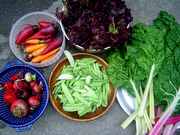

|
| Vegetable Varieties for Gardeners is a citizen science program
|
|
|
|
'Strawberry Spinach' Spinach |
| |
| Sub-Category: |
Summer
|
| |
|
| Sub-Category 2: |
| | Description: |
Cenopodium capitatum var. foliosum, not related to -- but used like -- spinach. Green, leafy 1- to 3-foot plants similar to the closely related lambsquarters. Also bears sweet, edible, red berries in its leaf axils. Warm-season crop. Start inside a few weeks before last frost date and plant out after danger of frost has passed. Readily reseeds. Also known as beetberry.
|
| Days To Maturity: |
NA
|
| Seed Sources: |
Seed Savers Exchange - updated in 2014
|
| |
| Rating Summary |
| |
Overall: (2.5 Stars)
Taste: (3.0 Stars)
Yield: (3.0 Stars)
Ease/Reliability: (2.8 Stars) |
| |
| Reviews |
| |
Login to share your Review of Strawberry Spinach.
Number of Reviews: 4
KEY: O=Overall Rating, T=Taste, Y=Yield, E=Ease
Reviewed on 08/11/2009 by
rolarase
- An intermediate gardener
|
 Overall Overall
 Taste Taste
 Yield Yield
 Ease Ease
|
St. Lawrence, New York, United States
Frost Free Season: 123 - 143 days
Soil Texture: Clay
Garden Size: Medium - 400 square feet to 1,600 square feet
Sun Exposure: More than 8 hours per day
|
| 2009 is the first year I've tried strawberry spinach and I must say I think it's great! The seeds were very slow to germinate, and germination was spotty, but the plants that came up are thriving. The "berries" are abundant and quite unique-tasting; very sweet with a berry-greens-corn flavor. I'm enjoying eating them out-of-hand and tossed in salads. The leaves are really tasty, too, in my opinion.
It can be invasive, so I've planted it where it won't affect anything else. I highly recommend it. |
| |
|
Reviewed on 07/16/2009 by
YorkerJenny
- An intermediate gardener
|
 Overall Overall
 Taste Taste
 Yield Yield
 Ease Ease
|
Onondaga, New York, United States
Frost Free Season: 123 - 143 days
Soil Texture: Clay
Garden Size: Large - More than 1,600 square feet (40' x 40')
Sun Exposure: More than 8 hours per day
|
| I tried to germinate in different times and different ways in 2008. Some of them finally showed up. Germination rate was horrible for me. The seeds are very very small and black, their colors turn to red when they start to germinate. They are so thinny, you gotta look at very closely to see if there is anything above the starter soil. Some of them achived to grow more and developed some leaves. The taste as row was so bad, I think grass tastes better. There were only few to cook. So, I couldn't try. As you can guess, there was no berry. Also there was no vine either. Meanwhile I bought the seeds from a good seed company, I assume they were fresh. Then in 2009 I tried again, when outside was warmer. Only one seed germinated and died after. Maybe it's not for this climate, it is suppossed to be kind a weed, so growing shouldn't be difficult.
I won't try again. |
| |
|
Reviewed on 05/25/2008 by
edgy
- An intermediate gardener
|
 Overall Overall
 Taste Taste
 Yield Yield
 Ease Ease
|
Maui, Hawaii, United States
Frost Free Season: More than 203 days
Soil Texture: Loam
Garden Size: Small - Less than 400 square feet (20' x 20')
Sun Exposure: More than 8 hours per day
|
| I rated this one low because I was looking for a warm-season leaf to add to salads, and I thought this had an extremely unpleasant taste.
The plants came up quickly enough, in a pot, but there is no verticality to them, and also no berries developed.
It could be that my climate is a problem; I don't know. |
| |
|
Reviewed on 05/04/2008 by
Slim Langer
- An intermediate gardener
|
 Overall Overall
 Taste Taste
 Yield Yield
 Ease Ease
|
Los Angeles, California, United States
Frost Free Season: More than 203 days
Soil Texture: Clay
Garden Size: Medium - 400 square feet to 1,600 square feet
Sun Exposure: 6 to 8 hours per day
|
| I've been searching for attractive perennial plants that work as perpetual greens in my mild climate to simply grow around the yard for cut and come again scissor harvest. I've been growing this for less than a year, starting some plants late last summer, and it seems to fit the bill and do well. It has tiny black seeds that are finicky and slow (2 weeks) to germinate, I believe requiring warm to hot (summer) temps to get started, but easily drying out. Once started, it had no trouble growing strongly through my mild winter, and growing much faster and better than actual spinach species. The leaves and (particularly sweet) stems are delicious raw or cooked. The form of the plant has been a thick, low, clumping bush of long rosetted stems and splayed saw-toothed leaves, the bush about 12 to 14 inches high, the leaves about 2-4 inches long. So far through the end of a very hot spring the plant has continued to grow well, though not produced any berries as of yet. I've started to grow some more of these plants. The ones I tried to start over the winter did not start; but these have. |
| | | 1 of 1 gardener found this review helpful.
|
|
|
|
|
Vegetable Varieties for Gardeners is a citizen science program, © 2004-2024, All Rights Reserved
Cornell Garden Based Learning, Cornell University College of Agriculture & Life Sciences, Horticulture Section
|






 VVfG home
VVfG home
 Overall
Overall Taste
Taste Overall
Overall Yield
Yield
